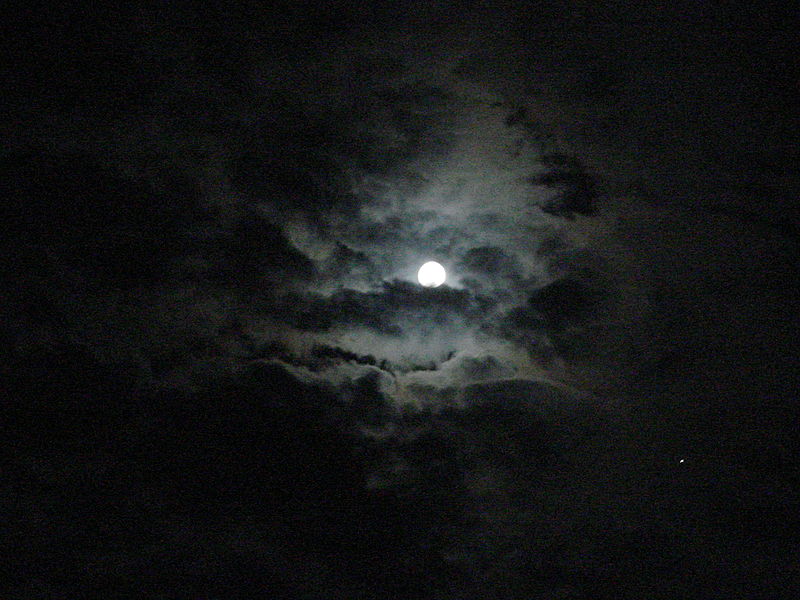In the late spring of 1967 I visited Florence in Italy, it was several months after the devastating flood that had engulfed Florence in November the previous year. I saw stains like plimsoll lines on the walls of buildings and in the churches I visited, huge dehumidifying machines were drying their interior walls. Life was slowly getting back to
normal.
Having greeted a copy of Michaelangelo’s sculpture of David outside of the Uffizzi Gallery, I went in to look at paintings. I came to Botticelli’s ‘ Spring’ it was exciting to see the original that had been painted nearly five hundred years earlier. Botticelli was a painter working in Florence during the era which has become known as the Renaissance; several schools of painting flourished, situated throughout much of Italy, the Northern and Venetian Schools, the Florentine and Central Schools being the most important, each put an emphasis on different aspects of painting.
The painting ‘Spring’ is an allegory. The work was painted with tempera on panel, tempera consists of ground pigments mixed with egg yolk, honey or glue and water, it is permanent and fast drying. I have experimented with egg tempera mixed with gouache paint, it is more suitable for painting on a panel rather than on canvas, because the paint tends to crack if not kept flat.
The setting for Spring is an orange grove, with plants scattered around, five hundred different varieties and one hundred and ninety different flowers, so I read, a botanical dictionary! Six mythological characters are situated across the space. The work is thought to resemble a Flemish tapestry, popular at the time.
The work was probably commissioned by Lorenzo de Medici for one of his cousins. Lorenzo Medici was an important patron of the Arts and left a lasting legacy of work. Much has been written about the Medici dynasty, mostly unfavourable, but the Arts did flourish during their time in power.
In the painting we see on the left hand side, a male pointing a wand towards the sky, three women are dancing in a circle next to him, in the centre is a female, dressed in a diaphanous white dress, around her is draped a red gown, her gaze is towards the viewer, her figure is framed by an archway of trees, a blind-folded putti is seen holding an arrow, hovering above her, next to her stands, almost floats, another female, her dress is decorated with plant designs and she wears a necklace of flowers. The wind we can see is blowing the flowing dresses from left to right. On the right of the painting we see another female character, also dressed in a diaphanous white gown with a garland of flowers flowing from her mouth and looking down intently at her is the second male figure, he has puffed up cheeks, he clasps her waist, the cold wind if March is now blowing in the opposite direction, I’m not sure what the significance of this change of direction signifies, perhaps the warming of the atmosphere as spring approaches?
There have been several interpretations of this painting, we know that Botticelli was interested in portraying Greek and Roman myths in addition to religious scenes and characters. If we think about the Roman myth, the male on the right would be the god Zephyrus, his cheeks full of wind, the god of wind, Zephyrus marries Chloris, she is shown in the painting with the flowers flowing from her mouth, after they marry Choris becomes the goddess Flora, goddess of flowers, she is next to Chloris. Venus the goddess of Love and Beauty is the central figure, an archetype who can be traced as far back as Paleolithic cave paintings and sculptures. In Helen Benigni’s book The Emergence of the Goddess, she writes ‘Venus appears to be part of what Carl Jung calls the transformative character of the primordial archetype where her image is seen as a regenerative force for change connected to the celestial order.’ To quote Robert Ellis in his book The Integration of Meaning he writes ‘the other way that art might relate more effectively to archetypes is in depicting them as symbolic forms rather than as objects in the world. In western art I find this particularly in the religious and mythological art of the Renaissance.’ To return to the painting, above Venus is Cupid who blindly points his arrow at Chastity, one of the three graces we see dancing in a circle, (the dance of time maybe?) the two other graces are Love and Pleasure. On the left hand side we see the god Mercury, he is pointing his wand to the sky, to brush away the wind, while Chastity looks at him.
Botticelli belonged to the Florentine School of painters, for them form and movement were their main objectives. Botticelli used a paint brush like a pen, his line work gave a feeling of movement, a linear rhythm. He was indifferent to representation, but was intent on presentation. Bernard Berenson wrote, ‘Botticelli was almost as if haunted by the idea of communicationg the unembodied values of touch and movement.’ He may have rivals in the East and Japan writes Berenson, but not in Europe, ‘his work possesses qualities that are life-enhancing and life- communicating, with quivering feeling containing values of touch and values of movement.’
Rober Ellis wites in the chapter The Integration of Meaning, when discussing the integration of visual art ‘ The central conflict within art reflects the tension within meaning in general – between representation and expression.’ Representation was not of primary importance to Botticelli, he was preoccupied with expressing the renewal of life and growth in this work, but he reaches a balance between the two. For Botticelli colour is less important than line, unlike the Venetian painters for example where the use of colour was very important. Berenson thinks that he is the greatest artist of linear design that Europe has ever had. His work went out of favour and was not appreciated again for a long time. He didn’t paint during the last ten years of his life, he died in 1510..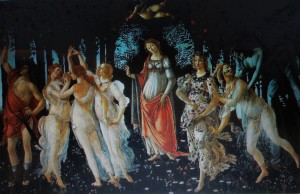
Monthly Archives: December 2013
Networks and the Middle Way
Recently I’ve been reading about network theory, an inter-disciplinary study related to complexity theory and systems theory. I’m very much struck both by how much it supports the approaches in Middle Way Philosophy, and by how it could help the presentation of it. Network theory studies the properties of any network: for example, the network of connections on the internet, the social connections between friends and relatives (online or offline), the connections between animals, plants, and non-organic elements in an ecosystem, or the neural connections in the brain. The illustration is of network connections on the internet, but it could conceivably be a diagram of any of a number of other types of complex network.
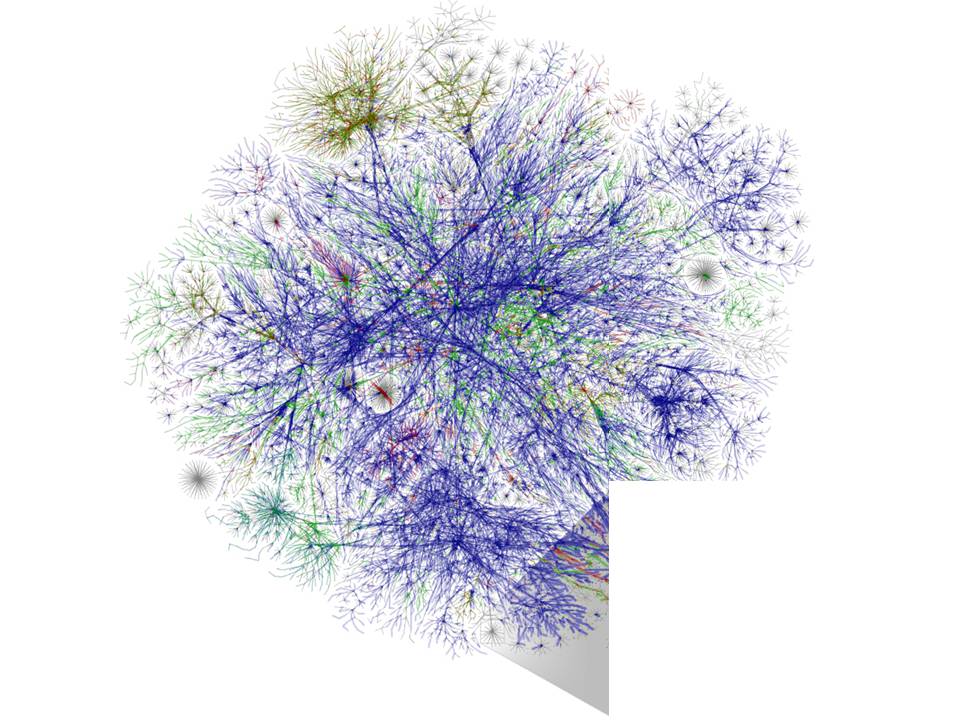
What makes a network complex (and thus not entirely predictable) is the potential for any element in it to connect to any other element. If you are connected to a computer (or smartphone) reading this now, you are part of a network that could potentially connect to many millions of other machines. If the network is your brain, then it is even more complex than the internet: there are an estimated 100 to 500 trillion neural connections in an adult human brain.
We’re more in the habit of thinking of social or ecological networks than of ourselves as networks, but if we can do so it could open up our thinking in many useful ways. We need to think of ourselves as a network of neural connections that is so mind-bogglingly complex that it can create consciousness, ego, experience, and all those other features we think of as ours. That model can make it easier to explain both how desire, meaning and belief relate to each other (all of them consist in neural connections or disconnections), and how our desires, meanings and beliefs can be more or less integrated – depending on how well interconnected the different parts of the network are. Of course, this is a simplification of the actual processes in the brain, but a model that might be helpful.
Network theory talks in terms of strong ties and weak ties between nodes on the network. In the picture, strong ties are the thicker lines, thinner the weaker ties. Strong ties, either in an individual brain or in a society, would correlate to strongly shared beliefs which are based on well-worn cognitive models. Weak ties, on the other hand, provide further potential beyond those well-worn channels, and might be associated with creative thinking and new metaphors. Two or more clusters of strong ties that are only weakly related to each other suggest unintegrated and possibly polarised beliefs. It is very difficult to say how far such patterns could actually be traced in a brain, where there would also be many other processes occurring, but I presume that this is what we would be able to see if we could isolate the pattern of neural connections that were most relevant to the beliefs concerned.
I think that the Middle Way might well be conceived as involving a balance between strong and weak ties in relation to our meanings and beliefs. We can have strong beliefs in the sense of lots of strong ties integrated into a single pattern, without neglecting weak ties. However, those with strong beliefs often unfortunately maintain them by trying to impose an exclusivity on the network that it cannot have. Imagine a part of a network with a strong central node and very strong links to other nearby nodes – but hardly any links beyond that. At a social level that would be the pattern of an exclusive cult, or an isolated authoritarian institution, and it would also be the pattern that members of such groups would try to impose on their brains. This kind of exclusive pseudo-network of strong ties would represent metaphysical belief. Of course, those who try to impose such a pattern on their brains do not completely succeed, because they continue to be embodied beings requiring all sorts of other neural links, but the dominance of left hemisphere function can still make such imposed patterns dominant in conscious experience, and do quite enough damage.
Alternatively one could potentially have lots of weak ties, and be very open to a variety of experiences and ways of thinking, but lack the core of strong ties that are necessary to be effective in practice. We can’t avoid having beliefs if we want to do anything, and when we act, the clearer and more comprehensive those beliefs are, the better. Lots of strong ties mean power, whether that the political power of a person in a social network or a belief in a neural one, because the more nodes that can be united by similar motives, the stronger the capacity to act.
Network theory also talks about equilibrium in a network. This is when the different elements in the network have no incentive to radically change the network. This state of equilibrium (also known as homeostasis) will occur when the network addresses the conditions it needs to address. This is perhaps easiest to see in an ecosystem, where different creatures can settle into a ‘balance’ despite the fact that they are probably eating each other. My suggestion would be that our best chance of addressing the complex and changing conditions around us in a sustainable way, and thus developing this equilibrium, is to maintain a balance of strong and weak links. That way we can both act effectively in the current situation and think flexibly when new conditions arise.
Picture: Internet connections by the Opte Project (Wikimedia Commons)
The three christmases
There seem to be three ways in which Christmas is meaningful to people. To Christians, Christmas is a celebration of the incarnation – of God coming to earth. To neo-pagans, Christmas is a celebration of the winter solstice. For consumerism, Christmas is an opportunity for self-indulgence, and its meaning lies in the ways that we hope to be made happy by exchanges of gifts and eating rich food. It seems to me that all three of these Christmases offer meaning in experience, but they also offer metaphysical beliefs that tend to hijack them.
The winter solstice is obviously something we all experience: or at least, those living in temperate or arctic regions of the northern hemisphere. There is a certain anxiety and foreboding about the increasing darkness, and a visceral desire for the light to return, that can make celebrating the winter solstice just a way of recognising these fears and hopes. But if it becomes part of a worship of ‘Nature’, or a desire to placate the gods of darkness, pagan beliefs are not really very far removed from theistic ones. The spring does not return because we ritualise our desire for it to do so, nor does ‘Nature’ make it return.
Consumerism, too, hits experience in some ways. We can feel, and renew, a connection with relatives by exchanging gifts with them and eating special food with them. However, an egoistic belief in ourselves and our objects of desire as unchanging can be strengthened by Christmas indulgence. Gifts can merely feed neomania, a cognitive bias that takes no account of how fast technology will change or how little gifts will matter over time. The gifts and sharing can also often just reinforce the projections in our relationships, perhaps because we haven’t resolved the archetypal view we have of parents, partners or children and recognised them fully as individuals beyond that role in our lives.
I can ride those two Christmases – they both mean something to me, but I hope not too much. A Middle Way in relation to them is relatively easy to see. However, it’s the Christian meaning of Christmas that is both more profound and more troubling. I don’t believe that God was incarnated in the form of Jesus – but I don’t deny it either. Such a claim is so obviously beyond experience that it is best left alone and not indulged one way or the other. Nevertheless, the incarnation is meaningful to me. What’s more, as someone from a culturally Christian background, I think that the profundity of its religious meaning is harder to get away from than I have often recognised. For many years I have just avoided Christmas by going away on retreat, but that has been an avoidance strategy that’s often stopped me really asking myself what it means.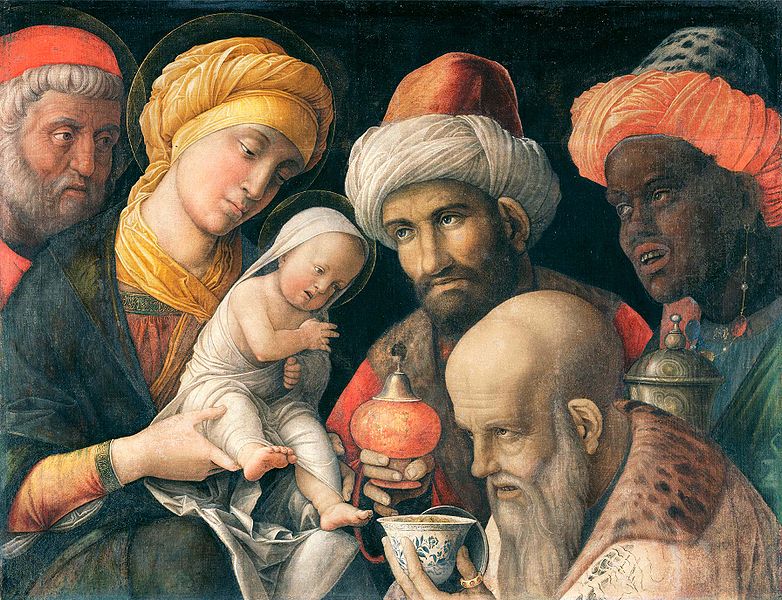
How is the incarnation meaningful to me when I don’t believe in it? I find this easiest to articulate in archetypal terms (if you’re unfamiliar with archetypes, see here). If God is a forward projection of the integrated psyche, the appearance of God in human form is a reassertion of the need to integrate the symbolic God into our lives. The incarnation thus represents the unlikely, baffling glimpses of the possibility of integration that we experience from time to time, often in the symbolic form of a wise old man or woman or of a mandala-like structure.
However, it’s one think to offer that explanation in theory and quite another to recognise it in experience. For me, it is the Renaissance painters who help me get to grips with this best. It seems that they really experienced that meaning fully and directly, and yet had a world-view close enough to the modern to represent it in a way we can relate to now. It is almost as though the Renaissance painters offer a moment between sleep and waking when the symbols are still vividly alive, yet we are still capable of considering them with full critical awareness. It is representations of the Annunciation that seem to capture it most often: a bewildered ordinary girl suddenly recognising a mind-boggling potential within herself. Sometimes, too, the Adoration of the Magi can offer something of that sense of awe in the face of the God archetype.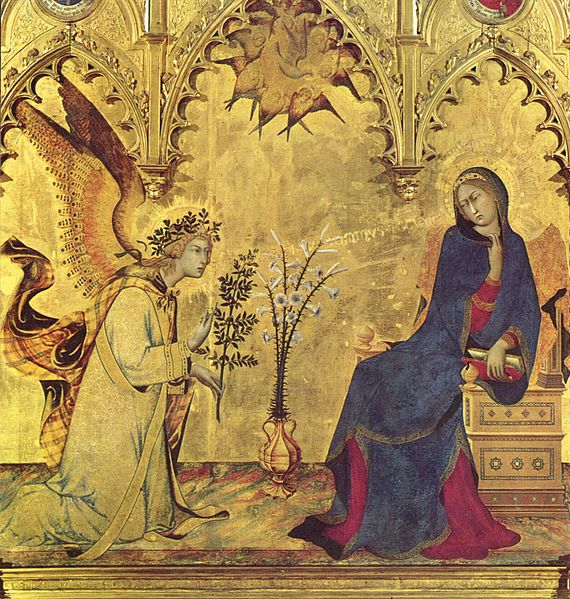
But I still fail to relate to the vast majority of what goes in churches in relation to Christmas. Not only is it still primarily about belief, but it is all still routinely objectified, trivialised, and sentimentalised. Are children in nativity plays, for example, given even the slightest glimpse of the possibility that the baby Jesus in the manger can mean something within themselves? Are the worshippers given any basic integrative practices – grounded in silence rather than endless metaphysical language – to help them cultivate the awe that they will need to recognise the meaning of Christmas? In the vast majority of churches, I think not.
So, here is my recommendation for an integrative reflection on the meaning of Christmas. Go to your nearest art gallery that has a decent collection of Renaissance art. Go when it is quiet, and preferably by yourself. Look at the Annunciations and the Nativities, and forget whatever you may have loved or hated about the story in school or church. Give yourself time to examine the pictures, and give space to allow awe to arise.
Pictures: Adoration of the Magi by Mantegna & Annunciation by Simone Martini (both public domain)
Poetry 8
Nocturne upon St. Lucy’s Day
‘Tis the year’s midnight, and it is the day’s,
Lucy’s, who scarce seven hours herself unmasks ;
The sun is spent, and now his flasks
Send forth light squibs, no constant rays ;
The world’s whole sap is sunk ;
The general balm th’ hydroptic earth hath drunk,
Whither, as to the bed’s-feet, life is shrunk,
Dead and interr’d ; yet all these seem to laugh,
Compared with me, who am their epitaph.
Study me then, you who shall lovers be
At the next world, that is, at the next spring ;
For I am every dead thing,
In whom Love wrought new alchemy.
For his art did express
A quintessence even from nothingness,
From dull privations, and lean emptiness ;
He ruin’d me, and I am re-begot
Of absence, darkness, death—things which are not.
All others, from all things, draw all that’s good,
Life, soul, form, spirit, whence they being have ;
I, by Love’s limbec, am the grave
Of all, that’s nothing. Oft a flood
Have we two wept, and so
Drown’d the whole world, us two ; oft did we grow,
To be two chaoses, when we did show
Care to aught else ; and often absences
Withdrew our souls, and made us carcasses.
But I am by her death—which word wrongs her—
Of the first nothing the elixir grown ;
Were I a man, that I were one
I needs must know ; I should prefer,
If I were any beast,
Some ends, some means ; yea plants, yea stones detest,
And love ; all, all some properties invest.
If I an ordinary nothing were,
As shadow, a light, and body must be here.
But I am none ; nor will my sun renew.
You lovers, for whose sake the lesser sun
At this time to the Goat is run
To fetch new lust, and give it you,
Enjoy your summer all,
Since she enjoys her long night’s festival.
Let me prepare towards her, and let me call
This hour her vigil, and her eve, since this
Both the year’s and the day’s deep midnight is.
John Donne
If there is a poem that you would like to suggest for this section, send it to me at barry@middlewaysociety.org and say in what way you feel it is meaningful to you.
Image courtesy of Wikipedia commons
The Third Phase
The universe – and our brains – are complex. Western civilisation has passed through differing phases in its treatment of that complexity, but it seems from all the signs that we are on the verge of a new one. In my view that change is potentially Copernican – a major upheaval in our world-view equivalent to realising that the universe does not revolve around us.
In the medieval era, complexity was ignored because of the over-simplifications of the ‘enchanted world’ and its unresolved archetypes. We mistook projections of our psychological functions for ‘real’ supernatural beings. A supernatural world provided a causal explanation for the world around us that prevented us from needing to engage with its complexity. The medieval era was gradually succeeded by the era of mechanistic science, in which linear causal mechanisms took the place of supernatural ones. Although we began to get to grips with the processes in ourselves and the universe, this was at the price of over-estimating our understanding of them, because we were using a naturalistic framework according to which, in principle, all events could be fully explained.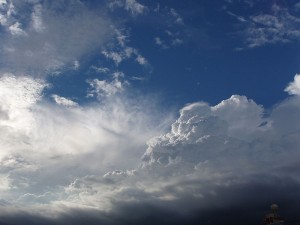
We are now gradually moving beyond this into a third phase of intellectual development. In this third phase, we not only develop models to represent the universe, but we also recognise and adapt to the limitations of these models. We take into account not only what we know, but what we don’t know. The signs of this third phase have been appearing in many different areas of intellectual endeavour.
- In mathematics and allied areas of science, there has been complexity theory and systems theory, which try to take into account the complexity of systems and the unpredictable ways in which complex systems operate, whether those systems involve the human brain, society, or global climate.
- In psychology, cognitive bias theory has increasingly mapped the kinds of errors that lead us to think we know things that we do not. We now recognise increasingly why we are so inclined to over-estimate our own knowledge.
- In cognitive science, linguistics and philosophy, embodied mind theory has revealed how much meaning, the building blocks of belief, is formed not by representations of the world, but by a bodily process that prevents us assembling direct representations of the universe.
- Nassim Nicholas Taleb has charted how much our estimates of ‘probability’ simply do not take into account the limitations of the experience on which these estimates are based, so that we remain unprepared for ‘black swans’.
- Iain McGilchrist, drawing again on the cognitive science of the brain, has charted the extent to which the representations of the left hemisphere of the brain can be built up in isolation from the right, giving us a deluded sense of having the whole picture.
These different types of recent work converge in telling us that we need to recognise the complexity and unpredictability of the complex systems we depend on – whether these are physical, chemical, biological, psychological, or social. Once we recognise how little we can actually predict the world, we have a reason to curb the arrogance of scientific naturalism and see it as an over-interpretation of the changing and fallible information we can gain by applying scientific method. The third phase of intellectual development is one that, at last, takes seriously the scepticism offered by Greek Pyrrhonians and Buddhists thousands of years ago. It does not abandon scientific theory or underrate its value, but offers more precise insights into its limitations.
The third phase has a dialectical relationship with the previous two. The thesis (the supernatural) conflicts with the antithesis (the natural). It is only by recognising the ways in which both of these address conditions that the other does not address that we can develop the synthesis, the Middle Way. The Middle Way, like the supernatural, recognises the limitations of our representations of the world, but like the natural, it also recognises the value of theory supported by experience in positively supporting those theories.
I think another aspect of the third phase must also engage with ethics in a way that none of the sources mentioned above do as yet. The first (supernatural) phase subordinated facts to values, so that we lived in a wholly moral world, whilst the second (natural) phase subordinated values to facts, so that ethics became relativised. The third phase needs to involve a recognition that facts and values are in practice interdependent, and that our ignorance of values is no worse than our ignorance of facts.
I do not want to try to predict the future. This nascent development of the third phase could still fizzle out and come to nothing. But the indications do offer some grounds for confidence that a third way of thinking is taking root. There will always be those who seem incapable of thinking beyond the terms of the first and second phases, or try to appropriate the third phase into one of the earlier ones. But their arguments may become increasingly irrelevant when the advantages of the third phase become better known and articulated.
The judgements we make under the influence of third phase thinking are different from those of the second phase because they can start to avoid the same arrogant disregard of uncertainty. They may at least help us cease making the same mistakes about the environment, about social intervention, about economic conditions or about our personal happiness. Fundamentally judgement in the third phase becomes a matter of balancing belief against ignorance, rather than merely an application of what is supposedly known. No doubt the third phase may in turn be superseded, but it will nevertheless be an advance on what went before.

